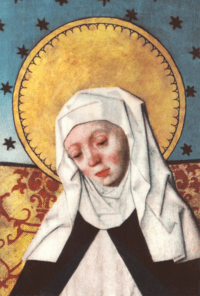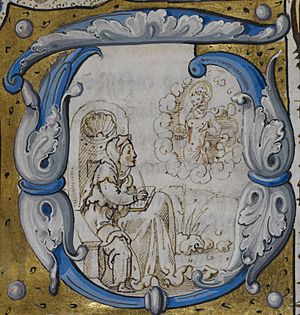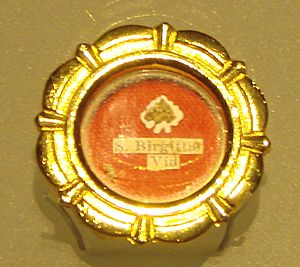Bridget of Sweden facts for kids
Quick facts for kids SaintBridget of Sweden OSsS |
|
|---|---|

Altarpiece in Salem church, Södermanland, Sweden (digitally restored)
|
|
| Widow, Mystic, Prophetic Witness, Renewers of the Church | |
| Born | c. 1303 Uppland, Sweden |
| Died | 23 July 1373 (aged 69–70) Rome, Papal States |
| Venerated in | Catholic Church Anglican Communion Lutheranism |
| Canonized | 7 October 1391 by Pope Boniface IX |
| Major shrine | Vadstena Abbey |
| Feast | 23 July 8 October (General Roman Calendar of 1960) 7 October (Sweden) |
| Attributes | Pilgrim's hat, staff & bag; crown, writing-book, heart with a cross, book and quill |
| Patronage | Europe, Sweden, Widows, for a holy death |
Bridget of Sweden, also known as Birgitta Birgersdotter or Saint Birgitta (Swedish: heliga Birgitta), was a special person who had deep spiritual experiences. She was a saint and a mystic, which means she felt a very close connection to God. After her husband passed away, she started a new group of nuns and monks called the Bridgettines (OSsS). She is also known as the "Princess of Nericia" and was the mother of Catherine of Vadstena.
Bridget is one of the six patron saints of Europe. This means she is considered a special protector for the continent. Other patron saints include Benedict of Nursia and Catherine of Siena.
Contents
Her Life Story
Bridget was born in Sweden around the year 1303. Her father, Birger Persson, was a knight and a very wealthy landowner. Her mother, Ingeborg Bengtsdotter, was related to the Swedish kings.
When Bridget was 13, in 1316, she married Ulf Gudmarsson. They had eight children together, four girls and four boys. Six of their children lived past infancy, which was quite rare back then. One of her daughters, Catherine, also became a saint. Bridget was known for her kindness and for helping people, especially single mothers and their children.
Later, she became the main lady-in-waiting to the new Queen of Sweden, Blanche of Namur. In 1341, Bridget and her husband went on a long journey, called a pilgrimage, to Santiago de Compostela.
In 1344, soon after they returned, Ulf died. After this sad event, Bridget decided to dedicate her life to prayer and helping those in need. She joined a group called the Third Order of Saint Francis.
Starting a New Religious Group
Bridget then had an idea to start a new religious community. It was called the Order of the Most Holy Saviour, or the Bridgettines. Their main home was at Vadstena Abbey. The King of Sweden, Magnus IV of Sweden, and his queen gave a lot of money to support this new group.
A unique thing about the Bridgettines was that they were double monasteries. This meant both men and women lived in the same community, but in separate areas. They promised to live simply and give any extra money to the poor. However, they were allowed to have as many books as they wanted!
In 1350, Bridget traveled to Rome, even though Europe was suffering from a terrible plague. Her daughter Catherine and a few friends went with her. She wanted the Pope to approve her new religious order. She also felt it was her job to help improve the moral behavior of people at that time.
The Pope was not in Rome then; he was living in Avignon, France. Bridget spent many years asking for the Pope to return to Rome. Finally, in 1370, Pope Urban V came back to Rome and approved the rules for her Order.
Bridget became very popular in Rome because of her kindness and good deeds. She stayed in Rome until she died on July 23, 1373. She kept pushing for changes and improvements in the Church.
Bridget was first buried in Rome, but her body was later brought back to Sweden. She was made a saint in 1391 by Pope Boniface IX.
Her Visions
When Bridget was ten years old, she had a vision of Jesus on the cross. From that moment on, Jesus' suffering became very important to her. She had many more visions throughout her life. These visions were written down in books called Revelationes coelestes ("Celestial revelations"). These books became very popular during the Middle Ages.
Vision of Jesus' Birth
Bridget's visions of the birth of Jesus had a big impact on how artists later painted this scene. Before she died, she described a vision where baby Jesus was lying on the ground, glowing with light. She also saw the Virgin Mary, with blond hair, kneeling and praying to her child.
Many paintings after Bridget's time showed this scene. They often included the ox and donkey, and used less light from other sources to make the "child of light" effect stronger. Joseph was often shown holding a single candle. The idea of Mary kneeling to pray to her child, known as the "Adoration of the Child," became very common in art.
The Fifteen Prayers
Saint Bridget wanted to know how many times Jesus was hit during his suffering. One day, Jesus appeared to her and told her he received 5,480 blows. He told her to say fifteen "Our Fathers" and fifteen "Hail Marys" along with special prayers for a whole year. By doing this, she would honor each of his wounds.
These prayers became known as the "Fifteen O's" because in Latin, each prayer started with "O Jesu" (O Jesus), "O Rex" (O King), or "O Domine Jesu Christe" (O Lord Jesus Christ). People aren't sure if Saint Bridget wrote all these prayers herself, but they were very popular in the Middle Ages.
These prayers were often found in prayer books. They helped people think about Jesus' suffering. They also included promises of special blessings for those who said them daily for a year. For example, some versions promised that fifteen family members would be released from Purgatory.
However, some of these promises were seen as too grand. In 1954, the Catholic Church said that while the prayers themselves are good, the promises linked to them are not reliable.
Honoring Saint Bridget
Many places honor Saint Bridget. In Vienna, Austria, a chapel was built for her in 1651. A whole new area of the city, Brigittenau, was named after her in 1900. In Sweden, a memorial stone was put up near Skederid Church, which her father built.
On October 1, 1999, Pope John Paul II officially named Saint Bridget a patron saint of Europe. Her special day, or feast day, is celebrated on July 23, the day she died.
The Vadstena Abbey, also known as the Blue Church, holds parts of Saint Bridget's body, which are honored by both Catholic and Lutheran Christians. She is also remembered by the Church of England and the Episcopal Church.
See also
 In Spanish: Brígida de Suecia para niños
In Spanish: Brígida de Suecia para niños
- Our Lady of Sorrows
- Pirita convent
- Rosary devotions and spirituality
- Societas Sanctae Birgittae
- Saint Bridget of Sweden, patron saint archive
Images for kids
-
Drawing of the tomb of Bridget's parents in Uppsala Cathedral
-
Saint Bridget in the religious habit and the crown of a Bridgettine nun, in a 1476 breviary
-
Pre-Bridget reclining Virgin with ox and donkey, circa 1311, by Duccio di Buoninsegna
-
Post-Bridget kneeling Virgin with Joseph holding a candle, circa 1470, by Hans Memling









